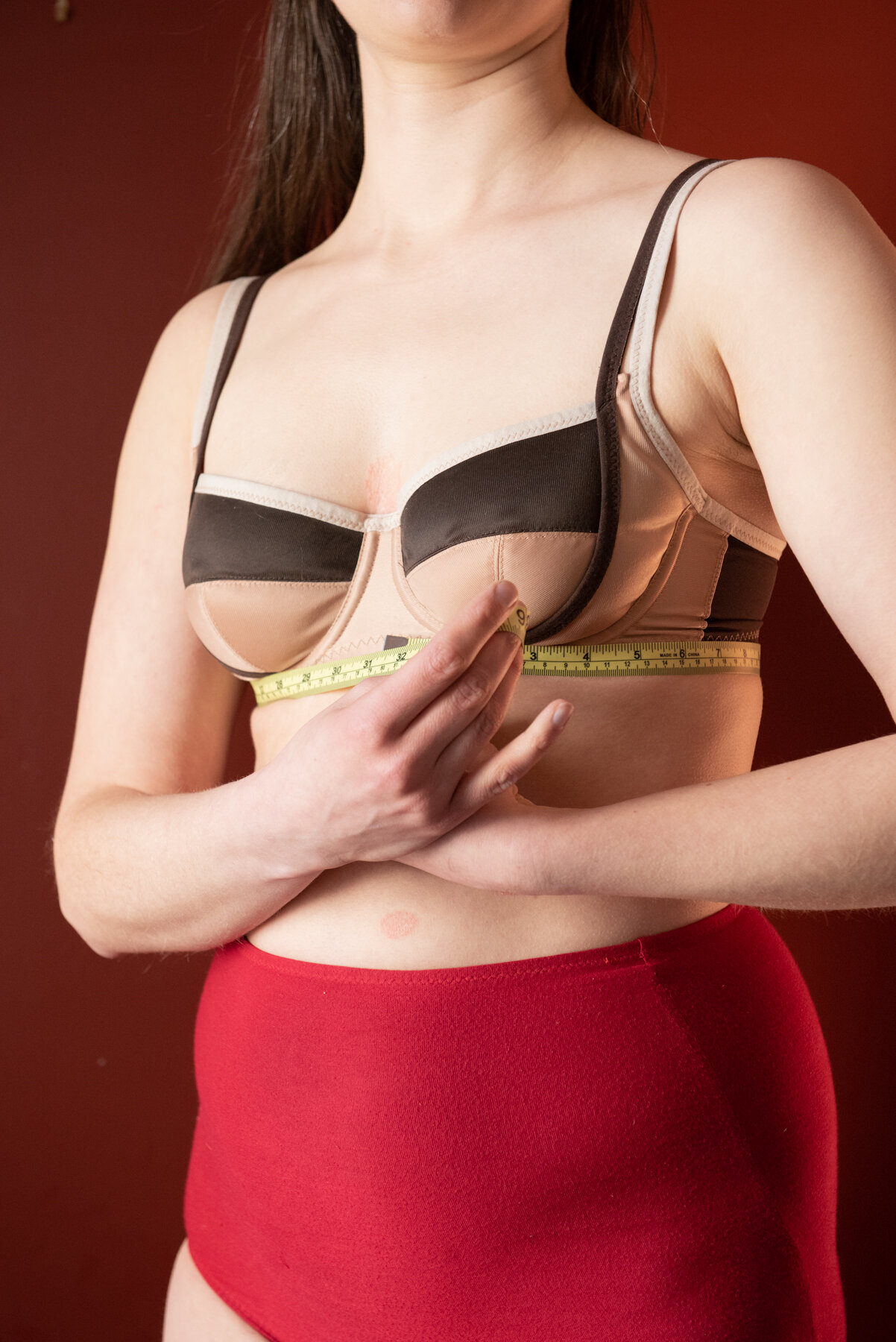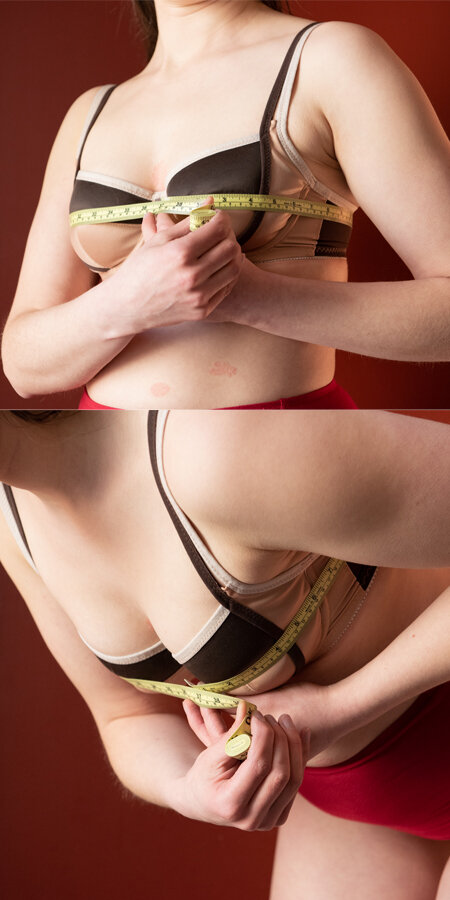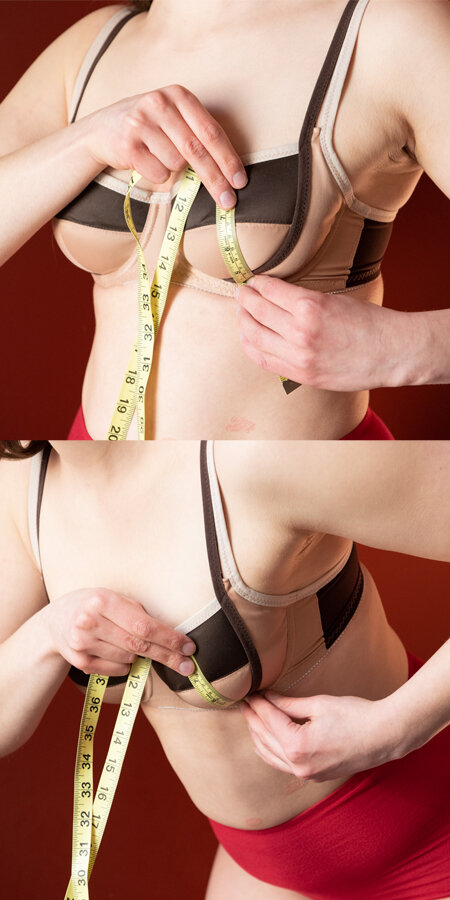How to Take Measurements for a Bra
Why can’t I just choose my bra size off the rack? A 36C is a 36C right?
Like all aspects of clothing manufacturing, sizing is not universal, and this is especially important to know when purchasing a close-fitting undergarment like a bra. Each pattern designer and manufacturer have their own ideas about the ideal figure that will fit each of their sizes.
I always suggest you start with your measurements, even if you are planning to purchase a RTW bra. The more information you have about your own body the better equipped you will be to advocate in the change room.
Use a soft tape measure, of the sort used for sewing, to take these measurements on your bare skin and record them to the nearest half centimeter (or quarter inch). If you do not have a tape measure, you can find them for a few dollars in places that sell sewing supplies (ex. Red Deer Sewing Centre, Red Deer Fabricland, Michaels). I am demonstrating these measurements over my bra in order to better respect your environment as you are viewing this blog post.
In terms of choosing a bra size, you’ve probably heard of the big two - ribcage measurement and full chest measurement. Your ribcage measurement might be your band size, or maybe you need to add 2 to 4 inches to that measurement to get your band size (every designer is different). And you determine your cup size by subtracting your band measurement from your full chest measurement. Each inch of difference is one cup.
Ribcage Measurement
With the tape measure parallel to the floor, exhale fully and ensure the tape measure is snug.
My ribcage usually measures approximately 30” in the summer and 31” in the winter. So I would want to look for band sizes of 30 if the designer doesn’t add a factor to get to the band size, or a 32 or 34 if they add 2 or 4 inches, respectively. Keep in mind that these numbers are just a starting point! Elastic tension can play a big role in how a bra band fits on our ribcage.
Full Chest Measurement
With the tape measure parallel to the floor, measure level with your nipple across the fullest part of your chest. The tape measure should not sag as you measure, but do not pull so tight as to distort the tissue. Exhale fully. If your breasts are pendant-shaped, you may need to bend over at the hips so the breast tissue hangs forward in order to get a more accurate measurement.
My full chest measurement is usually around 36”. So, to use my measurements as an example, I might start with the following sizes:
30 ribcage + 0 = 30 band; 36 - 30 = 6 which is an F cup (or DDD depending on the naming convention) —> looking for 30F/30DDD
30 ribcage + 2 = 32 band; 36 - 32 = 4 which is a D cup. —> looking for 32D
30 ribcage + 4 = 34 band; 36 - 34 = 2 which is a B cup. —> looking for a 34B
Do you see why a 36C is not always a 36C?
Additional Useful Measurements
These two previous measurements provide a decent starting place for determining bra size, but measuring your circumference really tells us nothing about how your tissue is actually distributed on your frame. For example, if you have a very narrow back, your full chest minus band might underestimate the size of the cup that you will require.
I like to take the following additional measurements because it helps me decide on a pattern size to use, but also this information can be useful for understanding your unique breast shape and how it might relate to RTW bras.
High Chest Measurement
Place the tape measure around your back, high up in your armpits and then over top of any fullness in your chest. Pull the tape measure snug and exhale fully. Please note that this measurement should not be taken when wearing a bra (even when doing this measurement for garment sewing) as we are trying to measure directly on your ribcage with no interference from breast tissue.
Some designers use high chest minus full chest to determine cup sizing. This method does not work well for anyone with broad shoulders as you can end up with a very small cup size suggested to you.
Bottom Cup Depth
Measure upwards vertically from your inframammory crease (the crease where your breast tissue begins - or where the underwire would sit) to your nipple following the contours of your breast. Measure both left and right sides and record them below. If your breasts are pendant-shaped, you may wish to repeat these measurements while bending over and then averaging the results between standing and bending for each side.
The Bottom Cup Depth measurement is where we start to measure your actual breast volume. This measurement is useful for people using a sewing pattern to make a bra, but this sizing information is generally not available to those purchasing a RTW bra. But more on how you can use this information below.
Horizontal Hemisphere
Measure horizontally across your breast tissue (crossing the nipple) from the inframammory crease at your underarm to the inframammory crease at your centre front. Record both left and right sides, and record them below. If your breasts are pendant-shaped, repeat these measurements when bending over and average the results between standing and bending for each side. The underarm crease can be hard to identify sometimes. Raise your arm on that side, gently support the breast with the other hand and slightly push it outwards towards your armpit - not pushing inwards at all, almost trying to rotate the breast around your ribcage. A crease will often form along the side of the breast that demarcates the inframammory crease. Mark that with a washable marker if you have one handy. If that doesn’t work, you can try to raise your arm again, and then reach around with the other hand to dig your fingers into your rib cage. Pull your fingers towards your front - you will feel when your fingers leave your rib cage and start to pull away into your breast tissue.
Again, the horizontal hemisphere measurement is useful for a person using a sewing pattern, but not directly useful for someone purchasing RTW.
For sewing, I always recommend starting with using the pattern designer’s method of determining your size. Then, if you are using a sewing pattern for low-stretch bra cups, you can measure the BCD and HH directly on the pattern tissue of the suggested size and compare it to your own.
How can I use BCD and HH measurements if I am purchasing RTW?
Generally, the standard-projection breast shape is that the HH measurement is twice the BCD plus one inch or so. Persons with this breast shape typically have less trouble finding RTW cups that fit them (this is not to say that these persons would not have trouble finding bras that fit them, the right cup shape might be easy to find but other factors may play a role in the ease of finding RTW such as strap attachment width, cylindrical or even flared ribs, etc.).
If your HH is significantly more than twice your BCD measurement plus 1”, you likely have a shallow-projected breast. Shallow-projected breast owners often find sports bras really comfortable as sports bras are designed to pull the breast tissue towards the chest, which results in a cup shape that closely mimics the actual shape of the shallow-projected breast. For a non-sports bra option, seek out minimizer bras (they are designed with a wider frame that you often need and a BCD to HH ratio that will be a closer match to your tissue than a standard cup would be) at your local bra boutique.
If your HH is significantly less than twice your BCD measurement plus 1”, you likely have a projected breast shape. This breast shape is often associated with large cups, but it can occur at smaller sizes too. In RTW bras, a person with this breast shape often has trouble finding bras that fit both the wire and and the cup volume. Often times, the wires end up poking you in the underarm or arm area as they are too wide for your shape. In terms of RTW, you will likely have more success finding bras at bra boutiques that are able to carry more specialty designs and sizes. (This breast shape is actually quite common, it is just not a shape that the big box manufacturers tend to include in their size range).
To use myself as an example again: I have a BCD of 9 cm and a HH of 20 cm. Half of 20 cm is 10 cm, which is pretty close to 9 - so I have a standard-projected shape.





